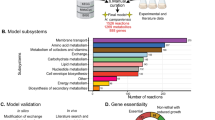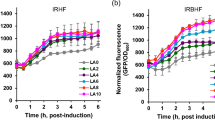Abstract
The key difference in the modified Embden–Meyerhof glycolytic pathway in hyperthermophilic Archaea, such as Pyrococcus furiosus, occurs at the conversion from glyceraldehyde-3-phosphate (GAP) to 3-phosphoglycerate (3-PG) where the typical intermediate 1,3-bisphosphoglycerate (1,3-BPG) is not present. The absence of the ATP-yielding step catalyzed by phosphoglycerate kinase (PGK) alters energy yield, redox energetics, and kinetics of carbohydrate metabolism. Either of the two enzymes, ferredoxin-dependent glyceraldehyde-3-phosphate ferredoxin oxidoreductase (GAPOR) or NADP+-dependent non-phosphorylating glyceraldehyde-3-phosphate dehydrogenase (GAPN), responsible for this “bypass” reaction, could be deleted individually without impacting viability, albeit with differences in native fermentation product profiles. Furthermore, P. furiosus was viable in the gluconeogenic direction (growth on pyruvate or peptides plus elemental sulfur) in a ΔgapnΔgapor strain. Ethanol was utilized as a proxy for potential heterologous products (e.g., isopropanol, butanol, fatty acids) that require reducing equivalents (e.g., NAD(P)H, reduced ferredoxin) generated from glycolysis. Insertion of a single gene encoding the thermostable NADPH-dependent primary alcohol dehydrogenase (adhA) (Tte_0696) from Caldanaerobacter subterraneus, resulted in a strain producing ethanol via the previously established aldehyde oxidoreductase (AOR) pathway. This strain demonstrated a high ratio of ethanol over acetate (> 8:1) at 80 °C and enabled ethanol production up to 85 °C, the highest temperature for bio-ethanol production reported to date.




Similar content being viewed by others
References
Basen M, Sun J, Adams MW (2012) Engineering a hyperthermophilic archaeon for temperature-dependent product formation. mBio 3:e00053–e00112
Basen M, Schut GJ, Nguyen DM, Lipscomb GL, Benn RA, Prybol CJ, Vaccaro BJ, Poole FL 2nd, Kelly RM, Adams MW (2014) Single gene insertion drives bioalcohol production by a thermophilic archaeon. Proc Natl Acad Sci USA 111:17618–17623
Bridger SL, Lancaster WA, Poole FL 2nd, Schut GJ, Adams MW (2012) Genome sequencing of a genetically tractable Pyrococcus furiosus strain reveals a highly dynamic genome. J Bacteriol 194:4097–4106
Bryant FO, Adams MWW (1989) Characterization of hydrogenase from the hyperthermophilic archaebacterium, Pyrococcus furiosus. J Biol Chem 264:5070–5079
Fardeau ML, Bonilla Salinas M, L’Haridon S, Jeanthon C, Verhe F, Cayol JL, Patel BK, Garcia JL, Ollivier B (2004) Isolation from oil reservoirs of novel thermophilic anaerobes phylogenetically related to Thermoanaerobacter subterraneus: reassignment of T. subterraneus, Thermoanaerobacter yonseiensis, Thermoanaerobacter tengcongensis and Carboxydibrachium pacificum to Caldanaerobacter subterraneus gen. nov., sp. nov., comb. nov. as four novel subspecies. Int J Syst Evol Microbiol 54:467–474
Fiala G, Stetter KO (1986) Pyrococcus furiosus sp. nov. represents a novel genus of marine heterotrophic archaebacteria growing optimally at 100 °C. Arch Microbiol 145:56–61
Fukui T, Atomi H, Kanai T, Matsumi R, Fujiwara S, Imanaka T (2005) Complete genome sequence of the hyperthermophilic archaeon Thermococcus kodakaraensis KOD1 and comparison with Pyrococcus genomes. Genome Res 15:352–363
Gao J, Bauer MW, Shockley KR, Pysz MA, Kelly RM (2003) Growth of hyperthermophilic archaeon Pyrococcus furiosus on chitin involves two family 18 chitinases. Appl Environ Microbiol 69:3119–3128
Gueguen Y, Voorhorst WG, van der Oost J, de Vos WM (1997) Molecular and biochemical characterization of an endo-beta-1,3- glucanase of the hyperthermophilic archaeon Pyrococcus furiosus. J Biol Chem 272:31258–31264
Keller MW, Schut GJ, Lipscomb GL, Menon AL, Iwuchukwu IJ, Leuko TT, Thorgersen MP, Nixon WJ, Hawkins AS, Kelly RM, Adams MW (2013) Exploiting microbial hyperthermophilicity to produce an industrial chemical, using hydrogen and carbon dioxide. Proc Natl Acad Sci USA 110:5840–5845
Keller MW, Lipscomb GL, Loder AJ, Schut GJ, Kelly RM, Adams MWW (2015) A hybrid synthetic pathway for butanol production by a hyperthermophilic microbe. Metab Eng 27:101–106
Kengen SW, Luesink EJ, Stams AJ, Zehnder AJ (1993) Purification and characterization of an extremely thermostable beta-glucosidase from the hyperthermophilic archaeon Pyrococcus furiosus. Eur J Biochem 213:305–312
Kengen SW, de Bok FA, van Loo ND, Dijkema C, Stams AJ, de Vos WM (1994) Evidence for the operation of a novel Embden–Meyerhof pathway that involves ADP-dependent kinases during sugar fermentation by Pyrococcus furiosus. J Biol Chem 269:17537–17541
Lian H, Zeldes BM, Lipscomb GL, Hawkins AB, Han Y, Loder AJ, Nishiyama D, Adams MW, Kelly RM (2016) Ancillary contributions of heterologous biotin protein ligase and carbonic anhydrase for CO2 incorporation into 3-hydroxypropionate by metabolically engineered Pyrococcus furiosus. Biotechnol Bioeng 113:2652–2660
Lipscomb GL, Stirrett K, Schut GJ, Yang F, Jenney FE Jr, Scott RA, Adams MW, Westpheling J (2011) Natural competence in the hyperthermophilic archaeon Pyrococcus furiosus facilitates genetic manipulation: construction of markerless deletions of genes encoding the two cytoplasmic hydrogenases. Appl Environ Microbiol 77:2232–2238
Lorentzen E, Hensel R, Knura T, Ahmed H, Pohl E (2004) Structural Basis of allosteric regulation and substrate specificity of the non-phosphorylating glyceraldehyde 3-phosphate dehydrogenase from Thermoproteus tenax. J Mol Biol 341:815–828
Ma K, Adams MW (2001) Ferredoxin:NADP oxidoreductase from Pyrococcus furiosus. Methods Enzymol 334:40–45
Matsubara K, Yokooji Y, Atomi H, Imanaka T (2011) Biochemical and genetic characterization of the three metabolic routes in Thermococcus kodakarensis linking glyceraldehyde 3-phosphate and 3-phosphoglycerate. Mol Microbiol 81:1300–1312
Mertens R, Greiner L, van den Ban ECD, Haaker HBCM, Liese A (2003) Practical applications of hydrogenase I from Pyrococcus furiosus for NADPH generation and regeneration. J Mol Catal B Enzym 24–25:39–52
Mukund S, Adams MW (1995) Glyceraldehyde-3-phosphate ferredoxin oxidoreductase, a novel tungsten-containing enzyme with a potential glycolytic role in the hyperthermophilic archaeon Pyrococcus furiosus. J Biol Chem 270:8389–8392
Müller V (2008) Bacterial fermentation. In: Sons JW (ed) Encyclopedia of life sciences. Wiley, Hoboken
Nguyen DMN, Schut GJ, Zadvornyy OA, Tokmina-Lukaszewska M, Poudel S, Lipscomb GL, Adams LA, Dinsmore JT, Nixon WJ, Boyd ES, Bothner B, Peters JW, Adams MWW (2017) Two functionally distinct NADP(+)-dependent ferredoxin oxidoreductases maintain the primary redox balance of Pyrococcus furiosus. J Biol Chem 292:14603–14616
Park JB, Fan CL, Hoffman BM, Adams MWW (1991) Potentiometric and electron nuclear double resonance properties of the two spin forms of the [4Fe-4S] + cluster in the novel ferredoxin from the hyperthermophilic archaebacterium Pyrococcus furiosus. J Biol Chem 266:19351–19356
Pisa KY, Huber H, Thomm M, Müller V (2007) A sodium ion-dependent A1A0 ATP synthase from the hyperthermophilic archaeon Pyrococcus furiosus. FEBS J 278:3928–3938
Roh Y, Liu SV, Li G, Huang H, Phelps TJ, Zhou J (2002) Isolation and characterization of metal-reducing Thermoanaerobacter strains from deep subsurface environments of the Piceance Basin, Colorado. Appl Environ Microbiol 68:6013–6020
Sapra R, Bagramyan K, Adams MW (2003) A simple energy-conserving system: proton reduction coupled to proton translocation. Proc Natl Acad Sci USA 100:7545–7550
Soboh B, Linder D, Hedderich R (2004) A multisubunit membrane-bound [NiFe] hydrogenase and an NADH-dependent Fe-only hydrogenase in the fermenting bacterium Thermoanaerobacter tengcongensis. Microbiology 150:2451–2463
Yu H, Wu C, Schut G, Haja DK, Zhao G, Peters JW, Adams MWW, Li H (2018) Structure of an ancient respiratory system. Cell 173:1636–1649
Acknowledgements
CT Straub acknowledges support from a US Dept of Education GAANN Fellowship (P200A160061). This work was also supported by grants to RMK and MWA (DE-PS02-06ER64304) from the Office of Biological and Environmental Research, Office of Science, US Department of Energy, and to MWA (DE-FG05-95ER20175) from the Division of Chemical Sciences, Geosciences and Biosciences, Office of Basic Energy Sciences of the Department of Energy.
Author information
Authors and Affiliations
Corresponding author
Additional information
Communicated by H. Atomi.
Publisher's Note
Springer Nature remains neutral with regard to jurisdictional claims in published maps and institutional affiliations.
Electronic supplementary material
Below is the link to the electronic supplementary material.
Figure S1.
During growth on pyruvate, P. furiosus catabolizes glucose via the ATP consuming phosphorylation of 3-phosphoglycerate (3-PG) followed by the NADPH-dependent reduction of 1,3-bisphosphoglycerate (1,3-BPG). The GAPN activity could potentially re-oxidize glyceraldehyde-3-phosphate (GAP) back to 3-phosphoglycerate (3-PG), creating an energy burning futile cycle (PDF 53 kb).
Figure S2.
Fermentation profile of P. furiosus strain RK304. Analysis from 50-mL defined 5 g/L cellobiose media in sealed serum bottle for 72 h (PDF 27 kb).
Figure S3.
Genetic construction of strains utilized in this study (PDF 47 kb).
Rights and permissions
About this article
Cite this article
Straub, C.T., Schut, G., Otten, J.K. et al. Modification of the glycolytic pathway in Pyrococcus furiosus and the implications for metabolic engineering. Extremophiles 24, 511–518 (2020). https://doi.org/10.1007/s00792-020-01172-2
Received:
Accepted:
Published:
Issue Date:
DOI: https://doi.org/10.1007/s00792-020-01172-2




